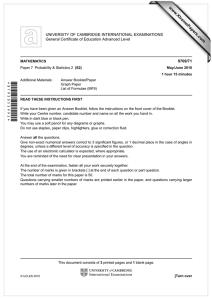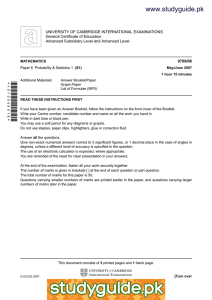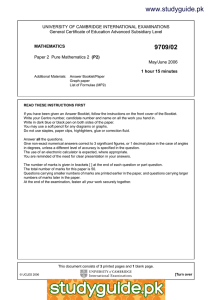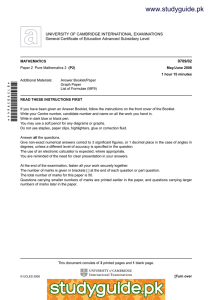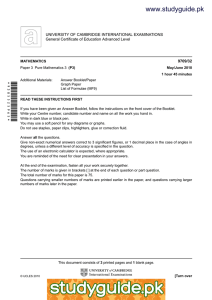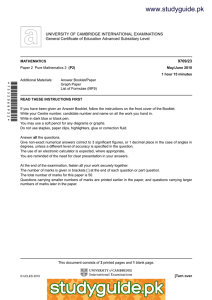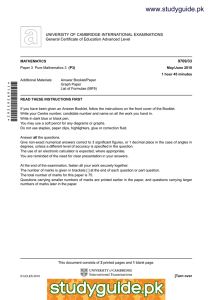www.studyguide.pk * 8 7
advertisement
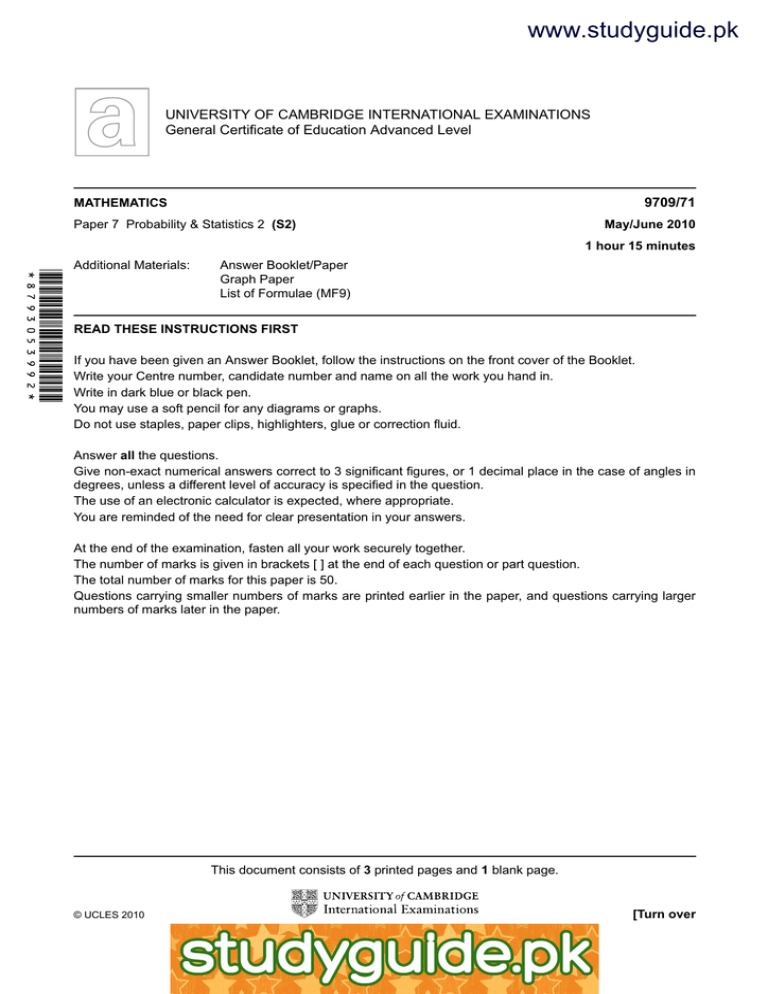
www.studyguide.pk UNIVERSITY OF CAMBRIDGE INTERNATIONAL EXAMINATIONS General Certificate of Education Advanced Level 9709/71 MATHEMATICS Paper 7 Probability & Statistics 2 (S2) May/June 2010 1 hour 15 minutes *8793053992* Additional Materials: Answer Booklet/Paper Graph Paper List of Formulae (MF9) READ THESE INSTRUCTIONS FIRST If you have been given an Answer Booklet, follow the instructions on the front cover of the Booklet. Write your Centre number, candidate number and name on all the work you hand in. Write in dark blue or black pen. You may use a soft pencil for any diagrams or graphs. Do not use staples, paper clips, highlighters, glue or correction fluid. Answer all the questions. Give non-exact numerical answers correct to 3 significant figures, or 1 decimal place in the case of angles in degrees, unless a different level of accuracy is specified in the question. The use of an electronic calculator is expected, where appropriate. You are reminded of the need for clear presentation in your answers. At the end of the examination, fasten all your work securely together. The number of marks is given in brackets [ ] at the end of each question or part question. The total number of marks for this paper is 50. Questions carrying smaller numbers of marks are printed earlier in the paper, and questions carrying larger numbers of marks later in the paper. This document consists of 3 printed pages and 1 blank page. [Turn over © UCLES 2010 www.XtremePapers.net www.studyguide.pk 2 1 f(t) k 0 12 time waiting (t) Fred arrives at random times on a station platform. The times in minutes he has to wait for the next train are modelled by the continuous random variable for which the probability density function f is shown above. 2 3 (i) State the value of k. [1] (ii) Explain briefly what this graph tells you about the arrival times of trains. [1] A random sample of n people were questioned about their internet use. 87 of them had a high-speed internet connection. A confidence interval for the population proportion having a high-speed internet connection is 0.1129 < p < 0.1771. (i) Write down the mid-point of this confidence interval and hence find the value of n. [3] (ii) This interval is an α % confidence interval. Find α . [4] Metal bolts are produced in large numbers and have lengths which are normally distributed with mean 2.62 cm and standard deviation 0.30 cm. (i) Find the probability that a random sample of 45 bolts will have a mean length of more than 2.55 cm. [3] (ii) The machine making these bolts is given an annual service. This may change the mean length of bolts produced but does not change the standard deviation. To test whether the mean has changed, a random sample of 30 bolts is taken and their lengths noted. The sample mean length is m cm. Find the set of values of m which result in rejection at the 10% significance level of the hypothesis that no change in the mean length has occurred. [4] 4 The weekly distance in kilometres driven by Mr Parry has a normal distribution with mean 512 and standard deviation 62. Independently, the weekly distance in kilometres driven by Mrs Parry has a normal distribution with mean 89 and standard deviation 7.4. (i) Find the probability that, in a randomly chosen week, Mr Parry drives more than 5 times as far as Mrs Parry. [5] (ii) Find the mean and standard deviation of the total of the weekly distances in miles driven by Mr Parry and Mrs Parry. Use the approximation 8 kilometres = 5 miles. [3] © UCLES 2010 9709/71/M/J/10 www.XtremePapers.net www.studyguide.pk 3 5 The random variable T denotes the time in seconds for which a firework burns before exploding. The probability density function of T is given by f (t ) = ke0.2t 0 0 ≤ t ≤ 5, otherwise, where k is a constant. (i) Show that k = 6 1 . 5(e − 1) [3] (ii) Sketch the probability density function. [2] (iii) 80% of fireworks burn for longer than a certain time before they explode. Find this time. [3] In restaurant A an average of 2.2% of tablecloths are stained and, independently, in restaurant B an average of 5.8% of tablecloths are stained. (i) Random samples of 55 tablecloths are taken from each restaurant. Use a suitable Poisson approximation to find the probability that a total of more than 2 tablecloths are stained. [4] (ii) Random samples of n tablecloths are taken from each restaurant. The probability that at least one tablecloth is stained is greater than 0.99. Find the least possible value of n. [4] 7 A hospital patient’s white blood cell count has a Poisson distribution. Before undergoing treatment the patient had a mean white blood cell count of 5.2. After the treatment a random measurement of the patient’s white blood cell count is made, and is used to test at the 10% significance level whether the mean white blood cell count has decreased. (i) State what is meant by a Type I error in the context of the question, and find the probability that the test results in a Type I error. [4] (ii) Given that the measured value of the white blood cell count after the treatment is 2, carry out the test. [3] (iii) Find the probability of a Type II error if the mean white blood cell count after the treatment is actually 4.1. [3] © UCLES 2010 9709/71/M/J/10 www.XtremePapers.net www.studyguide.pk 4 BLANK PAGE Permission to reproduce items where third-party owned material protected by copyright is included has been sought and cleared where possible. Every reasonable effort has been made by the publisher (UCLES) to trace copyright holders, but if any items requiring clearance have unwittingly been included, the publisher will be pleased to make amends at the earliest possible opportunity. University of Cambridge International Examinations is part of the Cambridge Assessment Group. Cambridge Assessment is the brand name of University of Cambridge Local Examinations Syndicate (UCLES), which is itself a department of the University of Cambridge. 9709/71/M/J/10 www.XtremePapers.net
